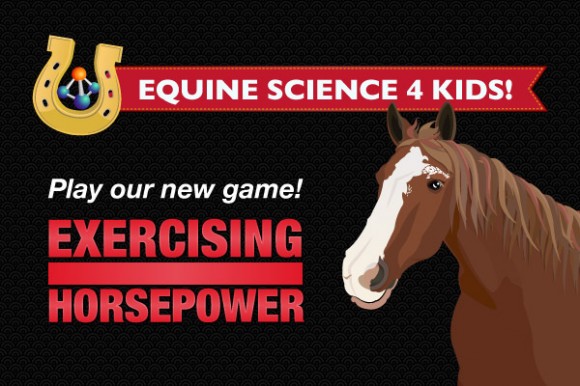 Recognizing the growing need to promote Science, Technology, Engineering, and Mathematics (STEM) education, the Equine Science Center at Rutgers University recently launched “Exercising HorsePower”, a new computer game based on equine exercise physiology laboratory practices. The game is available from the Center’s youth web portal.
Recognizing the growing need to promote Science, Technology, Engineering, and Mathematics (STEM) education, the Equine Science Center at Rutgers University recently launched “Exercising HorsePower”, a new computer game based on equine exercise physiology laboratory practices. The game is available from the Center’s youth web portal.
“Exercising HorsePower” was created as a teaching tool to introduce highly academic scientific research and concepts to youth ages 10-14 in a manner that is fun, interactive, educational and intuitive.
“We take the latest scientific research and technology and package it in a way that young people can understand and use. Introducing youth to equine science at an early age can be a powerful force in attracting students to the field and preparing budding scientists for successful careers,” said Karyn Malinowski, director, Equine Science Center. “A bonus for us is that, as a science center, we are advancing youth STEM education using the best models for human medicine – horses.”
“Exercising HorsePower” has distinct levels of game play which represent the stages of a standard equine exercise physiology research study: horse preparation, treadmill, and laboratory. Each level gets progressively more challenging. Players select one of three horses to complete the game. Each horse has unique abilities depending on age and prior condition, which will influence its performance on the treadmill and results in the laboratory.
After preparing the horse with the equipment needed to perform a graded exercise test, players run their horse on the treadmill at various speeds while collecting blood samples to process in the laboratory.
Once in the lab, players select which activity they want to measure: total protein or packed cell volume. Total protein is used to help determine hydration status, among other things, in horses. Packed cell volume is used to indicate an increase in red blood cells needed to meet higher oxygen demands during exercise.
In order to complete each activity, players utilize certain lab instruments and equipment including a centrifuge, refractometer, capillary tubes, pipettes, and a hematocrit card reader.
“What sets this game apart from other ‘online horse games’ is that, although it’s illustrated and animated, “Exercising HorsePower” provides an accurate representation of the core scientific research that is conducted in the equine exercise physiology laboratory at the Rutgers Equine Science Center,” added Malinowski.
The game was funded through a grant by the New Jersey Department of Agriculture.
For more information about “Exercising HorsePower”, contact Tiffany Cody at cody@njaes.rutgers.edu or 848-932-9419.
About Rutgers Equine Science Center
The Equine Science Center is a unit of the New Jersey Agricultural Experiment Station at Rutgers. Its mission is better horse care through research and education in order to advance the well-being and performance of horses and the equine industry. Its vision is to be recognized throughout New Jersey as well as nationally and internationally for its achievements in identifying issues in the horse industry, finding solutions through science-based inquiry, providing answers to the horse industry and to horse owners, and influencing public policy to ensure the viability of the horse industry.
For more information about the Equine Science Center, visit esc.rutgers.edu.

